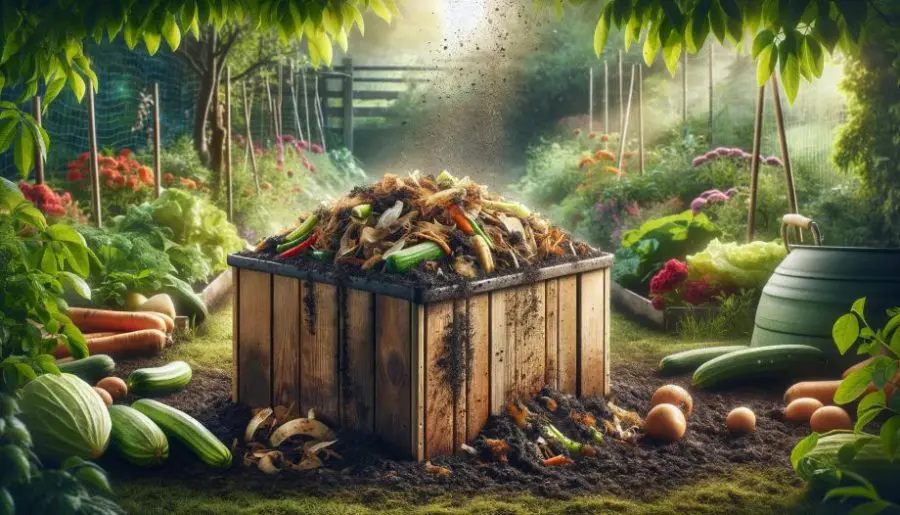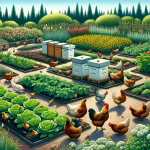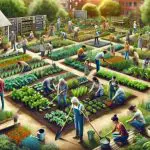
Discover the environmental benefits of permaculture and how it revolutionizes sustainable living. Dive into a world where nature and agriculture harmoniously coexist.
Benefits of Permaculture Key Takeaways:
- The environmental benefits of permaculture include improved soil health, increased biodiversity, efficient water use, and reduced carbon footprint.
- It integrates sustainable agriculture with natural ecosystems, promoting a balanced and eco-friendly approach to farming and living.
Ever wondered about the environmental benefits of permaculture? This sustainable approach is transforming our relationship with nature, offering a blueprint for an eco-friendly future.
Join us as we explore how permaculture is making a positive impact on our planet.
The Environmental Benefits of Permaculture
Permaculture is gaining momentum as a key player in sustainable agriculture.
This approach is more than just a method of farming; it’s a philosophy that harmonizes human activities with the natural environment, yielding mutual benefits.
At its core, permaculture revolves around principles that foster natural ecosystems and address pressing issues like climate change and food security.
By integrating these principles into daily practices, permaculture not only supports sustainable living but also enhances soil health and biodiversity.
This comprehensive guide delves into the environmental benefits of permaculture, exploring how it shapes a sustainable future in agriculture and beyond.
Key Takeaways
Permaculture offers a plethora of benefits:
- Waste reduction through efficient resource use.
- Improved soil and air quality.
- Enhanced water conservation.
- Boost in biodiversity.
- Promotion of organic farming.
- Ethical advantages in farming practices.
These key points highlight permaculture’s role in fostering a sustainable, regenerative agricultural system.
What Is Permaculture?
Permaculture is an approach to land management and settlement design that adopts arrangements observed in flourishing natural ecosystems. It includes a set of design principles derived using whole-systems thinking. It applies these principles in fields such as regenerative agriculture, town planning, rewilding, and community resilience. Wikipedia
Reduction in Waste
Permaculture stands out for its efficient use of resources, significantly reducing waste compared to conventional agriculture.
This system emphasizes the recycling of organic material and thoughtful observation of natural cycles, minimizing the need for external inputs.
By adopting practices like composting and waste management, permaculture transforms what would be waste in conventional systems into valuable resources.
This approach not only lessens the burden on landfills but also contributes to soil fertility, creating a closed-loop system that mirrors natural ecosystems.
The principle of ‘produce no waste’ in permaculture is a testament to its commitment to sustainable living, showcasing how every element in the system can be repurposed to benefit the environment.
Mitigating Soil Pollution

Permaculture’s approach to soil health is a game-changer in reducing soil pollution.
By steering clear of harmful chemicals and excessive use of fertilizers, this system maintains the natural balance of the soil.
The use of natural fertilizers, like compost made from organic matter, enriches the soil without the negative impact of chemical inputs.
This practice not only preserves soil fertility but also prevents soil erosion, a common issue in conventional farming. Permaculture principles, such as companion planting and crop rotation
Avoiding Harmful Chemicals:
In permaculture, the reliance on synthetic fertilizers and pesticides is replaced with natural, holistic methods.
This shift is crucial in preventing the accumulation of harmful chemicals in the soil, which can lead to long-term environmental damage and water pollution.
By embracing organic farming techniques, permaculture not only nurtures soil health but also safeguards the natural environment from toxic substances.
Natural Fertilizers:
Permaculture systems heavily utilize compost, green manure, and other organic materials as natural fertilizers.
These practices enrich the soil with essential nutrients, promoting soil fertility and microbial activity.
Unlike chemical fertilizers, natural alternatives do not contribute to soil erosion or degradation, ensuring sustainable soil management and higher crop yields in the long term.
Preventing Soil Erosion:
Soil erosion is a significant challenge in conventional agriculture, often exacerbated by over-cultivation and poor land management.
Permaculture addresses this through practices like crop rotation, companion planting, and the use of perennial plants.
These techniques not only maintain soil structure and reduce erosion but also enhance water retention and biodiversity.
By prioritizing soil health, permaculture contributes to the overall sustainability of the agricultural system.
Air Pollution Reduction
Permaculture’s impact extends beyond the soil, significantly reducing air pollution. This section examines how permaculture practices contribute to cleaner air and a healthier environment.
Reduced Machinery Use:
Permaculture systems often require less heavy machinery compared to conventional farming.
This reduction in machinery use leads to lower emissions of carbon dioxide and other pollutants, contributing to better air quality.
Carbon Sequestration:
Through practices like agroforestry and the planting of trees and shrubs, permaculture systems act as carbon sinks.
They absorb carbon dioxide from the atmosphere, mitigating the effects of global warming and climate change.
Sustainable Transportation:
Permaculture encourages local food production, which reduces the need for long-distance transportation of food products.
This decrease in transportation not only cuts down on emissions but also supports local economies and communities.
Groundwater Protection
Permaculture plays a vital role in safeguarding groundwater quality, an essential aspect of environmental health.
This section explores how permaculture practices contribute to the protection and sustainability of groundwater resources.
Enhancing Soil Permeability:
Permaculture designs often include techniques that enhance soil permeability, such as mulching and the use of organic matter.
Improved soil structure allows for better water infiltration, reducing runoff and preventing water pollution.
Natural Pest Management:
By avoiding synthetic pesticides, permaculture prevents these harmful chemicals from leaching into the groundwater.
Instead, it relies on natural pest management strategies, which are safer for the water table and the broader ecosystem.
Water-Saving Techniques:
Permaculture employs water-saving techniques like rainwater harvesting and drip irrigation, which minimize water usage and reduce the strain on groundwater sources.
These practices are particularly crucial in areas facing water scarcity and drought conditions.
Efficient Resource Use
Efficient use of resources is a cornerstone of permaculture, reflecting its commitment to sustainability and environmental stewardship.
This section highlights how permaculture maximizes resource efficiency for the benefit of both humans and nature.
Cycling of Resources:
Permaculture emphasizes the cycling of resources within the system. This includes reusing organic waste as compost, which nourishes the soil and reduces the need for external fertilizers.
Diverse Planting Strategies:
Diverse planting strategies in permaculture, such as polycultures and food forests, ensure more efficient use of available resources.
These systems mimic natural ecosystems, where different species coexist and support each other, leading to more resilient and productive environments.
Energy Conservation:
Permaculture designs often incorporate elements of energy conservation, such as passive solar design in buildings and the use of renewable energy sources.
This approach reduces reliance on fossil fuels and minimizes the overall carbon footprint of the system.
Sustainable Agricultural Practices
Permaculture is synonymous with sustainable agricultural practices, offering a blueprint for long-term environmental and agricultural health.
This section delves into how permaculture embodies sustainable agriculture.
Embracing Biodiversity:
Permaculture encourages the cultivation of a wide variety of plants, enhancing biodiversity.
This diversity is key to building resilience against pests and diseases, reducing the need for chemical interventions.
Soil Regeneration:
Regenerative agriculture is a fundamental aspect of permaculture. Techniques like crop rotation and green manuring contribute to soil regeneration, maintaining and improving soil health over time.
Water Management:
Efficient water management is integral to permaculture. Practices like swales and keyline design ensure optimal water usage, preserving this vital resource and supporting sustainable food production even in water-scarce regions.
Self-Production of Energy
Permaculture extends beyond agriculture, advocating for self-sufficiency in energy production.
This section explores how permaculture integrates renewable energy sources for a more sustainable lifestyle.
Solar Power Utilization:
Many permaculture systems incorporate solar panels, harnessing the sun’s energy for electricity and heating.
This reduces reliance on non-renewable energy sources and lowers the overall environmental impact.
Wind and Water Energy:
In some settings, permaculture designs include wind turbines or small-scale hydroelectric systems.
These renewable energy sources provide clean power, further reducing the carbon footprint.
Biomass Energy:
The use of biomass, such as wood from sustainably managed forests or biogas from organic waste, is another aspect of energy self-sufficiency in permaculture.
These systems turn waste into a valuable energy resource, closing the loop in resource use.
Long-Term Sustainability
Permaculture is deeply rooted in the concept of long-term sustainability.
This section examines how permaculture practices ensure enduring environmental and agricultural health.
Future-Focused Design:
Permaculture designs are created with the future in mind.
They aim to establish systems that will remain productive and sustainable for generations, addressing the needs of both current and future populations.
Adaptability and Resilience:
Permaculture systems are designed to be adaptable, and capable of withstanding environmental changes and challenges. This resilience is key to their long-term sustainability.
Education and Community Involvement:
Permaculture often involves educating and engaging the community, ensuring that sustainable practices continue and evolve.
This communal approach is vital for long-term success and environmental stewardship.
Risk Diversification in Farming
Permaculture offers a strategic approach to diversifying risks in farming, crucial for maintaining stability and productivity.
This section explores how permaculture contributes to risk management in agriculture.
Diverse Crop Selection:
Permaculture encourages the cultivation of a variety of crops.
This diversity reduces the risk associated with crop failure, as the impact of pests, diseases, or adverse weather is less likely to affect all crops equally.
Integrated Pest Management:
By promoting natural pest control methods and a balanced ecosystem, permaculture minimizes the risk of large-scale pest infestations that can devastate monoculture systems.
Climate Resilience:
Permaculture designs are tailored to local conditions, enhancing their resilience to climate change.
This adaptability ensures that farming systems can withstand various environmental stresses, securing food production in the face of changing climate patterns.
Organic Farming and Biodiversity
Organic farming within permaculture plays a pivotal role in enhancing biodiversity and ecosystem health.
This section discusses the interplay between organic practices and biodiversity in permaculture.
Chemical-Free Practices:
Organic farming in permaculture excludes the use of synthetic chemicals.
This approach not only protects soil health but also supports a wide range of flora and fauna, contributing to a richer biodiversity.
Habitat Creation:
Permaculture designs often include elements that create habitats for various species.
Features like ponds, hedgerows, and woodlands provide shelter and food for wildlife, fostering a balanced ecosystem.
Pollinator Support:
Organic farming practices in permaculture enhance pollinator health by providing a safe environment free from harmful pesticides.
This is crucial for maintaining populations of bees, butterflies, and other pollinators, which are essential for crop pollination and ecological balance.
Genetic Diversity:
Permaculture encourages the use of heirloom and native plant varieties, which contributes to genetic diversity in crops.
This diversity is key to resilience against diseases and changing environmental conditions.
Composting and Natural Fertilization
Composting and the use of natural fertilizers are fundamental in permaculture, enhancing soil health and reducing environmental impact.
This section delves into the benefits and processes of these practices in permaculture systems.
Composting Process:
Composting is a core practice in permaculture, turning organic waste into nutrient-rich soil amendments.
This process not only reduces waste but also improves soil fertility, providing plants with essential nutrients.
Benefits of Natural Fertilizers:
Natural fertilizers, such as compost and green manure, are gentle on the soil and the environment.
Unlike synthetic fertilizers, they do not cause water pollution or soil degradation.
These organic options contribute to sustainable soil management and long-term agricultural productivity.
Enhancing Soil Microbiology:
Using compost and natural fertilizers boosts soil microbiology.
The beneficial bacteria and fungi in compost help break down organic matter, improving soil structure and nutrient availability for plants.
Ethical Benefits and Community Aspects
Permaculture is not just about agricultural practices; it also encompasses ethical benefits and community-building aspects.
This section explores the social and ethical dimensions of permaculture.
Ethical Farming Practices:
Permaculture is grounded in ethics, including care for the earth and care for people.
These principles guide practices that are not only environmentally sustainable but also socially responsible, promoting fair treatment of workers and animals.
Community Engagement:
Permaculture often involves community-oriented projects, fostering a sense of cooperation and mutual support.
Community gardens, shared resources, and educational programs are examples of how permaculture brings people together for a common goal.
Local Food Systems:
By focusing on local food production, permaculture supports local economies and reduces the carbon footprint associated with long-distance food transport.
This approach also helps communities become more self-reliant and food secure.
Promoting Social Equity:
Permaculture projects can play a role in promoting social equity, and offering access to healthy food and green spaces in urban areas and underserved communities. These initiatives can bridge gaps and provide inclusive opportunities for all community members.
Environmental Benefits of Permaculture FAQs
Q: What is permaculture and how does it benefit the environment?
A: Permaculture is a sustainable approach to agriculture that integrates human activities with natural ecosystems.
It benefits the environment by enhancing soil health, conserving water, reducing waste, and promoting biodiversity.
Q: Can permaculture practices help combat climate change?
A: Yes, permaculture practices can combat climate change by reducing greenhouse gas emissions, enhancing carbon sequestration, and improving soil and water conservation.
Q: How does permaculture contribute to food security?
A: Permaculture contributes to food security by creating sustainable and resilient food systems that are less dependent on external resources and more adaptable to environmental changes.
Q: Is permaculture suitable for urban areas?
A: Absolutely, permaculture can be adapted to urban settings through practices like rooftop gardens, vertical farming, and community gardens, making sustainable agriculture accessible in cities.
Q: How does permaculture support biodiversity?
A: Permaculture supports biodiversity by encouraging a variety of plant and animal species, creating habitats, and avoiding harmful chemicals, all of which contribute to a healthier ecosystem.
Benefits of Permaculture Conclusion
Permaculture is more than just a farming technique; it’s a sustainable lifestyle choice that harmonizes human activities with the natural world.
Its environmental benefits are far-reaching, from improving soil and air quality to conserving water and enhancing biodiversity.
By adopting permaculture practices, we can contribute to a healthier planet and a more sustainable future.
This comprehensive guide underscores the importance of permaculture in shaping sustainable agricultural practices and highlights its potential in addressing global environmental challenges.






